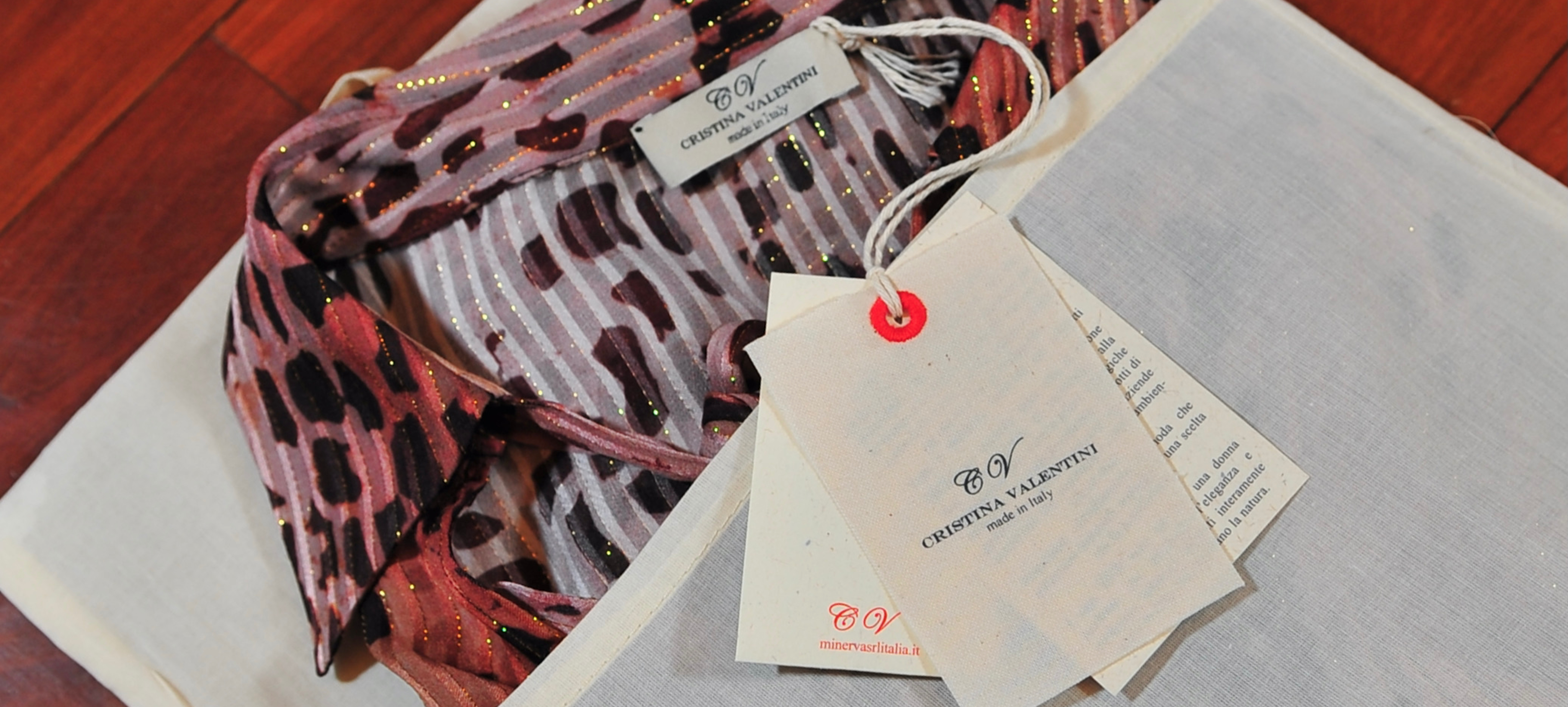MATERIALS
Products’ quality and richness are the result of making the most of specific fabrics and precious craftsmanship. CV-- offers the finest pure silk, organic cotton, and viscose. They are all produced in Italy by Italian companies that stand for excellence and are among the most important players worldwide in the luxury sector.
ECOTONE
It is produced with organic cotton characterized by a high-quality extra-long fiber that comes from organic farming. It is naturally hypoallergenic, breathable, and comfortable. This fabric’s production is entirely traceable and carried out without the use of chemicals while carefully paying attention to energy and water saving.
CRÈPE SATIN
It is a 100% percent silk fabric in satin weave with a crepe and matte texture – it can be just called Satin. Characteristics of this fabric are its sheen and smoothness. The shiny side is normally used, but to produce the orange-peel effect the reverse side can also be worked.
CRÈPE DE CHINE
The warp is in shiny silk, the weft is in silk crepe high twist yarn with a plain weave. The shiny silk of the warp contrasts the matte finish of the weft in silk crepe high twist yarn, the twist gives a “bubbly” orange-peel look, typical of this fabric.
CRÈPE DE CHINE STRETCH
It is a plain weave dress fabric that highlights the contrast between the shine of the warp and the matte weft. Characteristic of this fabric is the fine weft in soyeline, silk crepe spun with an elastomer that lends practicality and ease.
COTTON SATEEN STRETCH
In this fabric the warp thread prevails, and the satin weave lends sheen together with comfort of the stretch cotton. Made with a weft of cotton spun with elastomer, this fabric has a semi-lustrous and ease appearance.
SILK SATIN STRETCH
Made with very closely spaced warp threads of lustrous silk and a weft of satin crepe spun with a fine elastomer called soyeline and satin weave. Principal features are fluidity and comfort.
TAFFETA
The fabric’s name comes from the Persian "tafheh" that means "sheer silk fabric". It is a luxury fabric, made with yarn-dyed organzino yarn both in warp and weft. Silk taffeta has a softly iridescent sheen and a sustained, crisp hand, and plain weave. One of its characteristics is the typical rustling sound that the pure silk fabric makes when the wearer moves.
VISCOSE
Viscose is a highly breathable fabric which gives a touch of freshness to the body and for this reason it is very pleasant to
wear it in direct contact with the skin. It was born precisely with the name of vegetable silk, because it was created by man specifically
to emulate the characteristics of softness of natural silk.
Viscose is an artificial fiber extracted from vegetable cellulose; not a natural fiber nor a synthetic fiber as many say, but a textile fiber
that uses a part of raw material of natural origin and a part of synthetic chemicals, and is obtained through various chemical processes in the laboratory.
The raw material used is not always the same, mostly trees or other materials of plant origin are used.
The cashmere we use comes from Mongolia, on the border with the Gobi Desert, where a peculiar breed of goats has adapted to the harsh
environments and extreme temperatures.
To survive, the goats develop wonderfully thick coats made up of a coarse outer guard hair and a fine, soft undercoat.
They have been bred for thousands of years by the same people who only select the finest fibre.
Only the downy undercoat is selected depending on its length, colour and thickness.
Goats are not sheared; they are combed in the spring collecting the undercoat that runs from the throat to belly.
This yields a tiny amount; it takes a yearlong fibre from two or three goats to knit
one CV- article.
Farming activities are managed and taken care of by nomadic breeders. For years the spinner has been encouraging sustainable
herding and grazing practices, promoting high standards of animal welfare, and protecting this traditional way of life within
nomadic communities.
Welfare, sustainability, and traceability are the three pillars of the cashmere industry’s ethical sourcing initiatives.
The yarn used to produce CV- articles comes from Todd & Duncan,
long-time Scottish spinner with 150 years of expertise.
It is produced in the historic mill of Loch Leven using modern technologies but pursuing quality according to the tradition of the past.
COnly the best fibres are selected with careful processes of carding and spinning.
The dyeing phase is carried out through the pure water from Loch Leven; this is fundamental for the handle and the final result of the cachemire.
Today Loch Leven hosts a world-renowned nature reserve. All the water that is used, returns to the loch – cleaned to make sure the brown trout,
pink-footed geese and 35,000 wintering birds can thrive. The type of yarn used for
CV - articles is 2/28 with a gauge that goes
from 14.5 to 15 micron.
Only the finest and longest white down is selected to this purpose, to guarantee the highest quality of insulation and hygroscopy,
and the highest resistance to pilling.
Cachemire, at the same weight, is up to 10 times warmer than wool. Each phase of the articles’ production is entirely carried out in
Tuscany by skilled craft hands.
ACCESSORIES

Labels, hangtags, packaging items are all ecofriendly, made with recycled raw materials or with low environmental impact. The refined bag made of organic cotton to accompany, is purposely conceived to carefully store the article and to be reused.
BUTTONS

We exclusively use real mother-of-pearl buttons, extracted from the world’s most beautiful shells. Environmental awareness and safeguarding are guaranteed by the innovative purification and suction technological systems. For every shell collected, another one takes its place. All materials come from non-exploitative sources and non-endangered species. Large photovoltaic systems allow to produce a large part of the consumed energy, thereby reducing the emission of pollutants and carbon dioxide into the atmosphere.